Listen to This Article:
The baker in you wants to spend your days making chewy cookies and decadent cakes. The entrepreneur in you wants to be your own boss and call the shots. But the realist in you knows that you may not have the resources or the time to start your own retail bakery.
The solution could be a home-based bakery!
This type of small business lets you bake to your heart’s content, be your own boss, and work from home, instead of leasing an expensive storefront and hiring a squad of employees.
If you’re trying to figure out how to start a bakery business from home, you’re in the right place. Here’s a guide to turning your home kitchen into a small-batch production powerhouse.
Note: Auguste Escoffier School of Culinary Arts does not provide financial advice. Always consult with a professional to determine what is best for your situation.
1. Research and Plan Your Home Bakery Business
Before you start getting excited about recipes and baking, you’ll want to invest some time in business planning. One of the first tasks on your to-do list is to do some market research. Who are the other home-based and retail bakeries in your area? What kinds of products do they sell, and how much do they sell them for? More importantly, where do they sell them? The answers to these questions will help you have a better chance of success, as you can get a sense of what has worked for other similar businesses in your area.

One way to decide what product to make is to learn about what other local bakeries are making. Is there a missing niche you can fill?
With this information in hand, consider what market niche you would like to fill. Is there a clear opening in the market for one type of baked good? Maybe no one is making gluten-free pastries, or there is a lack of custom cakes. Or, you could choose something that you have an extra special skill in—something you know you can do better than anyone else—like artisan bread, or mini cupcakes.
Then, it’s time to create a business plan.** Pencil out how you might make your business work money-wise (see below). Though it may feel like a lot of work up front, creating a plan that makes economic sense before you invest your time and money can save you a lot of headache later on and set you up for success.
**Auguste Escoffier School of Culinary Arts does not provide financial advice. Always consult with a professional to determine what is best for your situation.
2. Make Sure You’re Legally Set Before Doing Anything Else
A home-based bakery is a business, which means it’s still subject to state and local laws around food, business licensing, and taxes. Additionally, there are nuanced laws surrounding the sale of food items from one’s home.
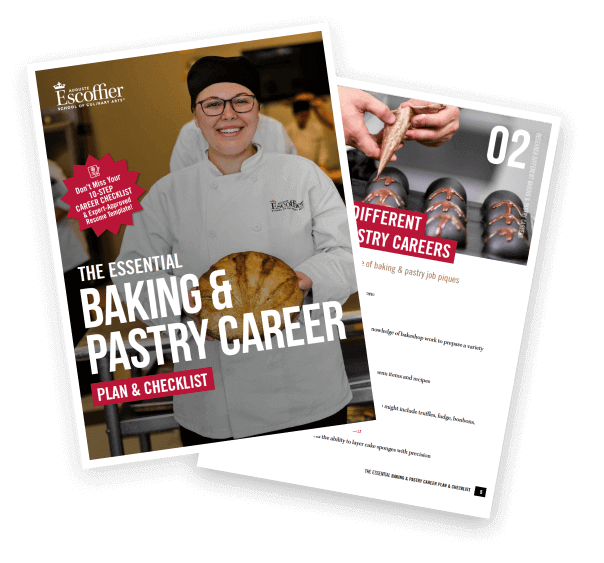
Get the Baking & Pastry Career Plan & Checklist
Aspire to be a pastry chef or baker? Use this 10-step checklist that includes a 90-second career assessment quiz and resume template to take the next step!
Here are some general guidelines, but since laws vary from location to location, make sure to consult your local food and business regulatory agencies before moving forward!
Know Your Local Cottage Food Laws, Inside and Out
Home bakeries are generally covered by a section of law called cottage food. This classification can separate home-based bakeries from commercial or retail operations that have designated storefronts or production kitchens. Commercial bakeries have to meet certain requirements for equipment and sanitation, while cottage-food operations can have their own sets of rules.
Cottage food is regulated on a state-by-state basis, but it’s often limited to shelf-stable products that don’t require refrigeration…perfect for baked goods!

Warm, flaky croissants can be made in a home-based bakery business.
To make sure these home-based food businesses don’t get too expansive (in order to prevent large-scale operations from skirting the regulations of a retail bakery), cottage bakeries usually have a sales limitation. They also have rules regarding who you can sell to. A cottage bakery is generally for direct-to-consumer sales only, so you can’t sell to a local grocery store or bakery.
The first step in the process is to assess the rules where you live. Your state and local health departments should be able to provide additional information on your area’s cottage food laws.
Create a Business Entity and Get Licensed
When you start a home baking business, there are other legal stipulations to consider before you tie on your apron. Some states may require you to carry a business license to operate your home bakery. You may need a food manager license from the health department as well, depending on your state.
You should also set up a business entity, like a limited liability company (LLC). Setting up a company, versus operating your business as an individual or sole proprietor, can protect your personal assets from legal liability in the event of a lawsuit. You may also need an insurance policy. Check with a cottage food expert and/or an attorney for advice on the best way to proceed.
Organize Your Finances and Plan for Taxes
One of the cardinal rules in business is to always keep your business banking separate from your personal banking. This means setting up a separate business bank account, which you can do once you’ve created your company.
You may also have to charge sales tax and/or food tax on the items you sell. You’ll need to keep careful track of your sales and document their breakdowns, so you can pay the proper amount of local and state taxes.
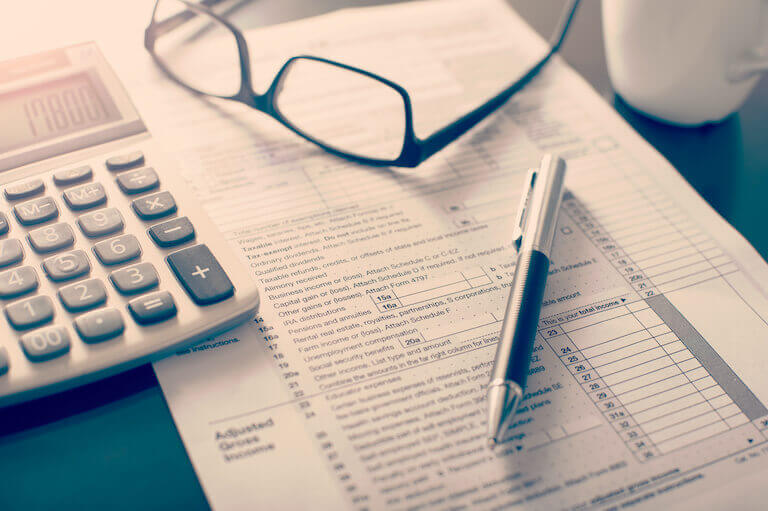
As a bakery owner, keeping track of your finances will keep you prepared for filing your taxes.
3. Plan Your Bakery Menu
Once you understand the rules and regulations, have your company set up, and you’ve done your market research, you can start the fun part! Many home-based bakeries make cookies, breads, muffins, cupcakes, or cakes on a daily basis. As your own boss, you can choose to make whatever you like best (and choose not to make anything that you don’t enjoy). For example, Auguste Escoffier School of Culinary Arts baking and pastry student Katie Sualog makes legendary biscotti in her home-based bakery!
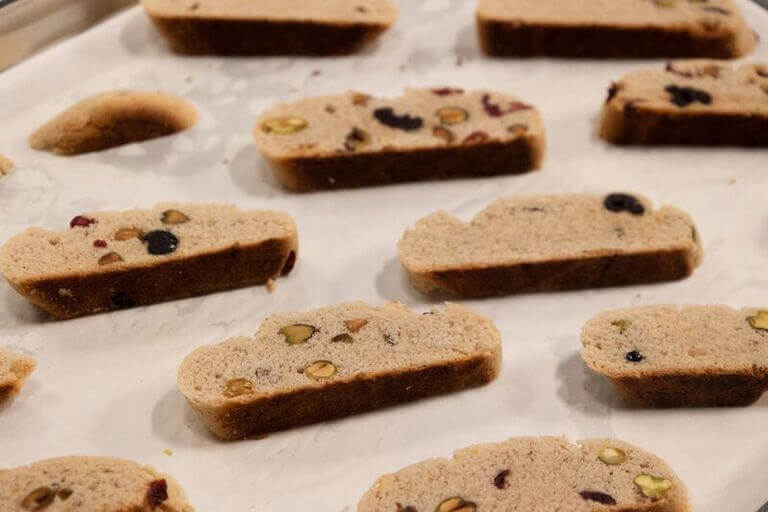
Freshly baked biscotti can make a great addition to a home-based bakery menu.
Make sure to keep local laws in mind while planning your menu! Remember, in most cases, the end product must be shelf-stable, so anything that requires refrigeration is usually not an option.
One of the best things about a home bakery is that it can be flexible. Let’s say you go to the farmers market one weekend to sell pre-cut slices of banana bread. You hear from a few people that they love your banana bread and wish they could buy a whole loaf! Well, that’s easy for you—next weekend, you can offer both slices and whole loaves for those who want them, versus having to stick to a predetermined menu. You can also switch things up whenever you like, experimenting with different ingredients or scaling back when things get a bit too busy.
Not sure what to bake? An education in Baking & Pastry Arts from Escoffier can introduce students to many different types of baked goods. And with the online program, students can practice their techniques right in their home kitchens—perfect for the aspiring home-based baker.
4. Set Up Your Home Bakery
Once you know what you’ll be baking, you can get what you need to execute your offerings. Whether that’s assorted cake or muffin tins, bread tins, cupcake wrappers, piping bags, and tips—make sure you have everything ready to go and a place to store it all.
You may already have some home baking equipment, but you might need to upgrade to heavier duty or larger equipment. Be sure to check out local or online commercial kitchen supply stores or explore online options like Craigslist or eBay to find deals on used equipment.**
**Auguste Escoffier School of Culinary Arts does not provide financial advice. Always consult with a professional to determine what is best for your situation.
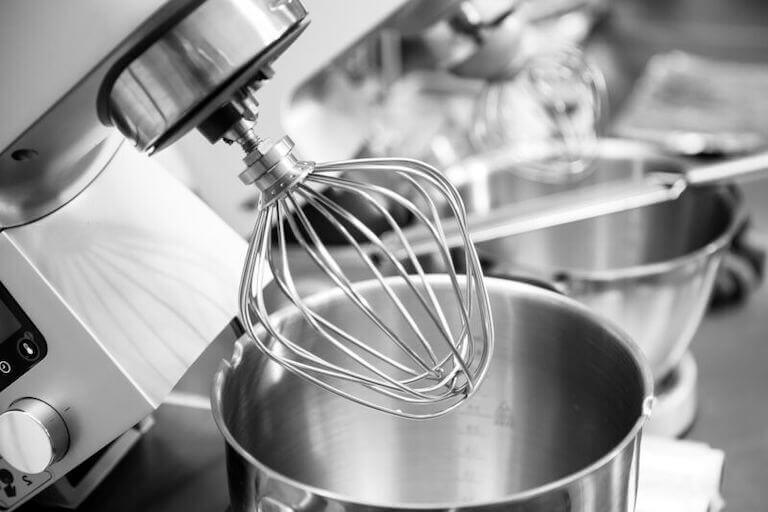
You may need to upgrade your kitchen equipment to meet the demands of your new venture.
And unless your kitchen is already set up for larger-scale baking, you may need to rearrange your space to accommodate your new project. For example, you may need additional storage shelves or containers and places to keep your equipment.
Some states’ cottage food laws require that you keep your bakery equipment separate from your personal kitchen equipment, so keep those extra space needs in mind. Make sure to track the cost of all of your supplies, so you can account for them when you price your menu and do your taxes.
Which leads us to…
5. Price Your Baked Goods to Promote Profitability
Pricing your baked goods takes much more than simply looking at what your competitors charge and doing the same. Your baked goods may cover your costs of ingredients, labor, and additional overhead like business fees and farmers market fees, with some still left over for profit. But how can you figure out all of those numbers?**
**Auguste Escoffier School of Culinary Arts does not provide financial advice. Always consult with a professional to determine what is best for your situation.
Calculate Your Food Costs
Build a spreadsheet of each ingredient that you use, plus the cost of each in common denominations. For example, you could list the costs of:
- a pound of flour
- a pound of sugar
- a dozen eggs
- a pound of butter
- a tin of baking soda
- …and so on
Then, use that information to calculate the food cost of each recipe.
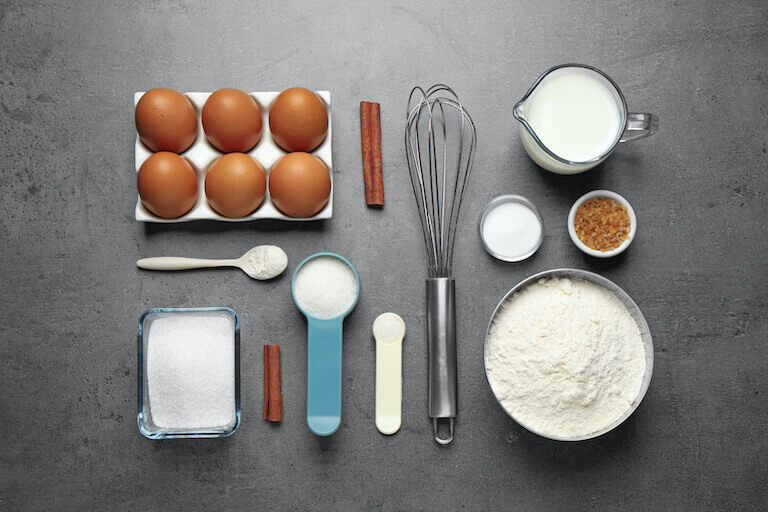
As a home bakery business owner, it’s important to accurately calculate the true cost of goods sold (COGS) to stay profitable.
Maybe you plan to sell cupcakes. Based on your spreadsheet, you can calculate the cost of the flour, sugar, baking soda, vanilla, eggs, etc. that go into your recipe for a single batch. If a dozen eggs cost $5.00, and you use two eggs in your recipe, you’ll know that the cost of those two eggs is $0.83.
Let’s estimate that your cost per batch of cupcakes is $6.00. Then, divide that total batch cost by the number of cupcakes in a batch. For a $6.00 batch that yields 24 cupcakes, your cost per cupcake would be $0.25 – $6.00/24 cupcakes = $0.25 per cupcake. Remember, this is only the cost of the ingredients required to make the goods.
Calculate Your Labor Cost
Next, you can assess how long it takes you to make a batch of those cupcakes. Perhaps it may take you two hours to mix the batter, bake, decorate, and package two dozen cupcakes.
How much would you expect to be paid hourly if you worked in a bakery? Let’s say you might be paid $15 per hour. So a batch of your cupcakes would be worth $30 of your time.
Now, we can figure out the labor per cupcake. Divide the total dollar value of your time by the number of cupcakes. $30/24 cupcakes = $1.25 labor per cupcake.
Calculate Your Overhead Costs
Consider what other expenses you may incur for your business. This could include fixed costs like farmers market fees and maintaining a monthly website. It can also include variable fees that change based on how much you sell (like labels and packaging costs) plus cooking needs (think parchment paper and cupcake liners.)
These values can be challenging to estimate before you have some experience and know approximately how many items you’ll sell per month, but you can do your best to estimate a total monthly overhead and divide it by the number of items you expect to sell per month. When getting your start, you may want to underestimate your sales, in order to be conservative.
For easy math, let’s say your monthly costs are $100, and you sell 400 items per month, for an overhead cost of $0.25/item. $100 overhead/400 items = $0.25 per item.
Assess Your Cost of Goods Sold
Cost of goods sold (referred to in the industry as COGS) is the total cost of producing all the items you plan to sell. Add each of these individual costs up to get your cost of goods for a single cupcake!
In our example: $0.25 food cost + $1.25 labor cost + $0.25 overhead costs = $1.75 per cupcake.
Cost of Goods Sold (COGS)
Your cost of goods sold estimates the true costs of producing one unit of product.
Cost of Goods Sold = Food cost + Labor cost + Overhead Costs
To get your shop’s COGS, you can repeat this process for each item you sell.
6. Decide Where to Sell Your Home-Baked Treats
Now it’s finally time to fire up your ovens and bake plenty of your best treats. Once they’re packaged, it’s time to head out to sell!
Many home-based bakers sell their goods onsite at events like farmers’ markets, music festivals, or county fairs. Check your local and state regulations for where you can and can’t sell home-based bakery goods (as well as laws of other states if you plan to ship or travel).
You may (depending on state regulations) also be able to sell your baked goods from your own website or through social media. On these platforms, you’ll want to make sure customers have a clear way to place an order, so you don’t miss out on valuable sales. This means you’ll want to set up clear pathways for your customers to reach you and place an order. It’s up to you how you’d like this to look, whether it’s by email, phone, online, via text, or all of the above. Make sure you clearly let your customers know how much lead time you need for a custom order.
You’ll also want to consider how you’ll fulfill orders. Will your customers meet you at your home, or will you deliver or require pick up at your weekly farmer’s market or other event?
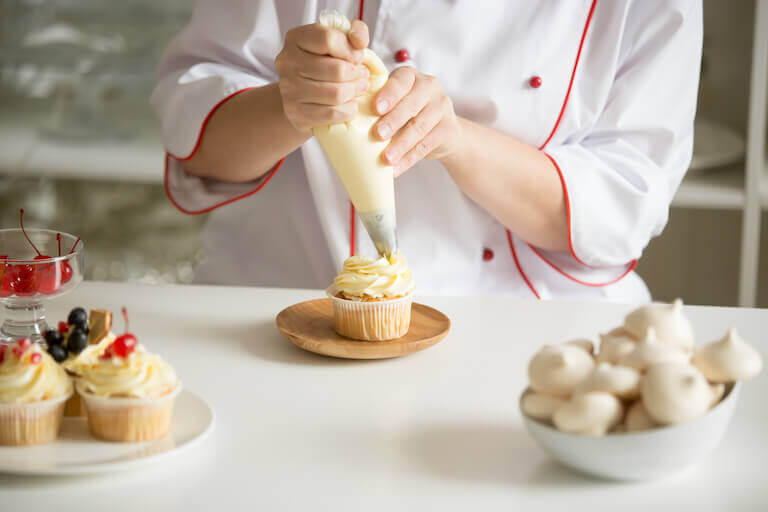
Making baked goods is only part of success for a home-based bakery business. You must also learn how to promote your wares so customers can find you.
7. Promote Your Home Baking Business
Showing up with baked goods ready to sell is a start. But with some marketing and promotion, you can get people excited about finding your stand at the local farmers market or other local events. You can also encourage customers to make custom orders.
A successful business has easily recognizable branding. Think of how much information you intuit about a product when you see a common corporate logo, like the Nike swoosh.
When it comes to your home bakery business, you’ll want to start with a catchy, easy-to-remember name. Once you have that, you may want to invest in creating branding materials, like a logo and packaging, to set your products apart from the competition. You can work with a local graphic designer, or hire someone online through a company like Fiverr. Just make sure your packaging meets all the health and safety requirements.
Visual social media platforms like Instagram and TikTok are great places to share images and videos of your beautifully frosted cookies and cakes, tagged with your logo. You can promote weekly specials or incentivize consumers to engage with your brand through a special giveaway. You can use social media to show customers your behind-the-scenes process. (Don’t forget to factor in the time you spend on marketing and promotion, as well as the costs of any digital tools you pay for, into your COGS.)

Social media posts can help market your business by showcasing your bakery masterpieces.
You can also create a simple website that includes a menu, ordering information, and contact information. You can and should link to this information on your social media sites.
But any small-scale, home-based business will rely on word of mouth. This always starts with encouraging your existing network, like your family or friends, to try out your new products. Encourage them and your new customers by handing out punch cards to your loyal customers and trying a “buy 9 cookies and get one free” offer. And to really draw them in, a few free samples never hurt. A taste of one of your perfect macarons and people will be eager for more.
Not Sure If You’ve Got the Skills to Start a Home Baking Business?
A home bakery is a business, just like a retail bakery. While it may have its own set of rules and regulations, it must still abide by the same principles of great baking, customer service, cost control, and marketing.
If you’re not sure if you have all of these skills, it may be time to invest in an education by attending pastry school—which may prepare you for every facet of your home baking business. With Escoffier’s Online Programs in Baking & Pastry or Food Entrepreneurship, you can earn a diploma or an associate degree from your own home!
Contact our admissions department to learn more.
FOR MORE INFORMATION ON BAKING AND PASTRY CAREERS..
- What are the Career Opportunities in Baking & Pastry?
- How to Become a Baker
- Which Culinary Career is Right for You? 5 Tips for Choosing a Career in Food
This article was originally published on April 16, 2022 and has since been updated.
*Information may not reflect every student’s experience. Results and outcomes may be based on several factors, such as geographical region or previous experience.


